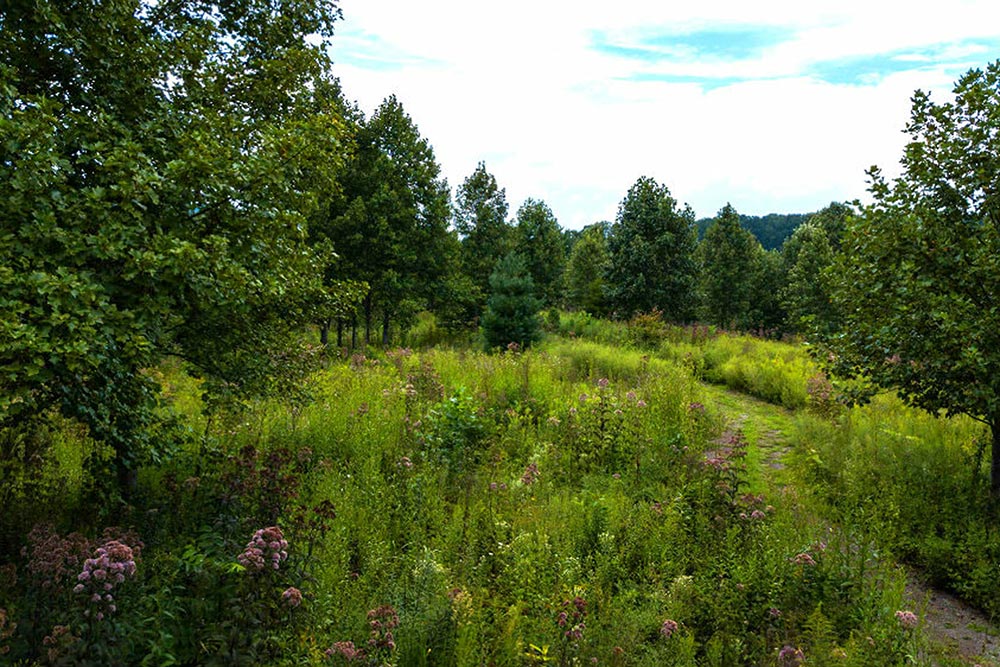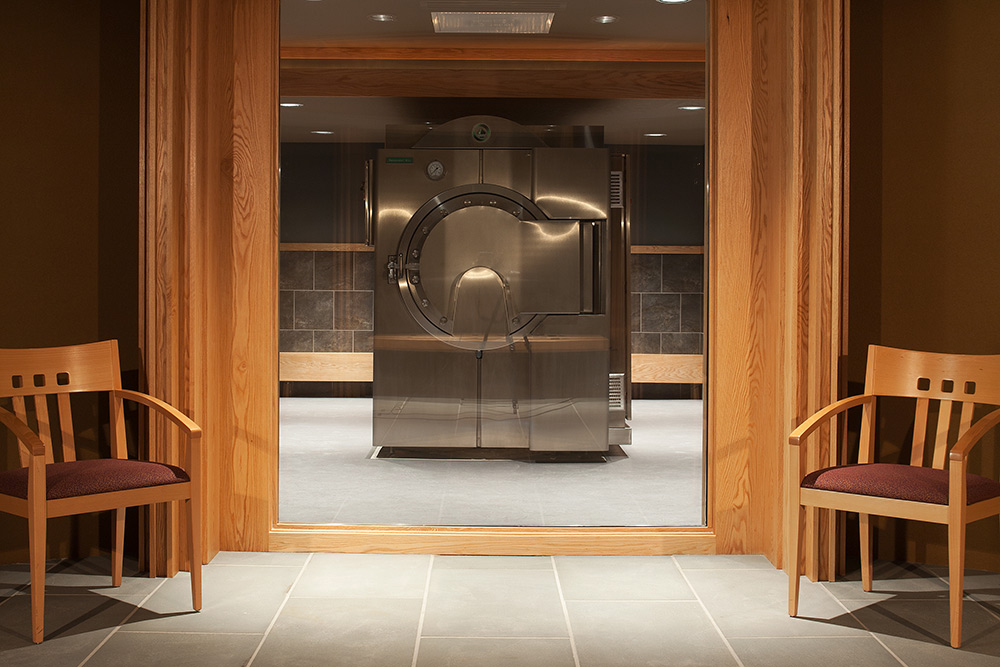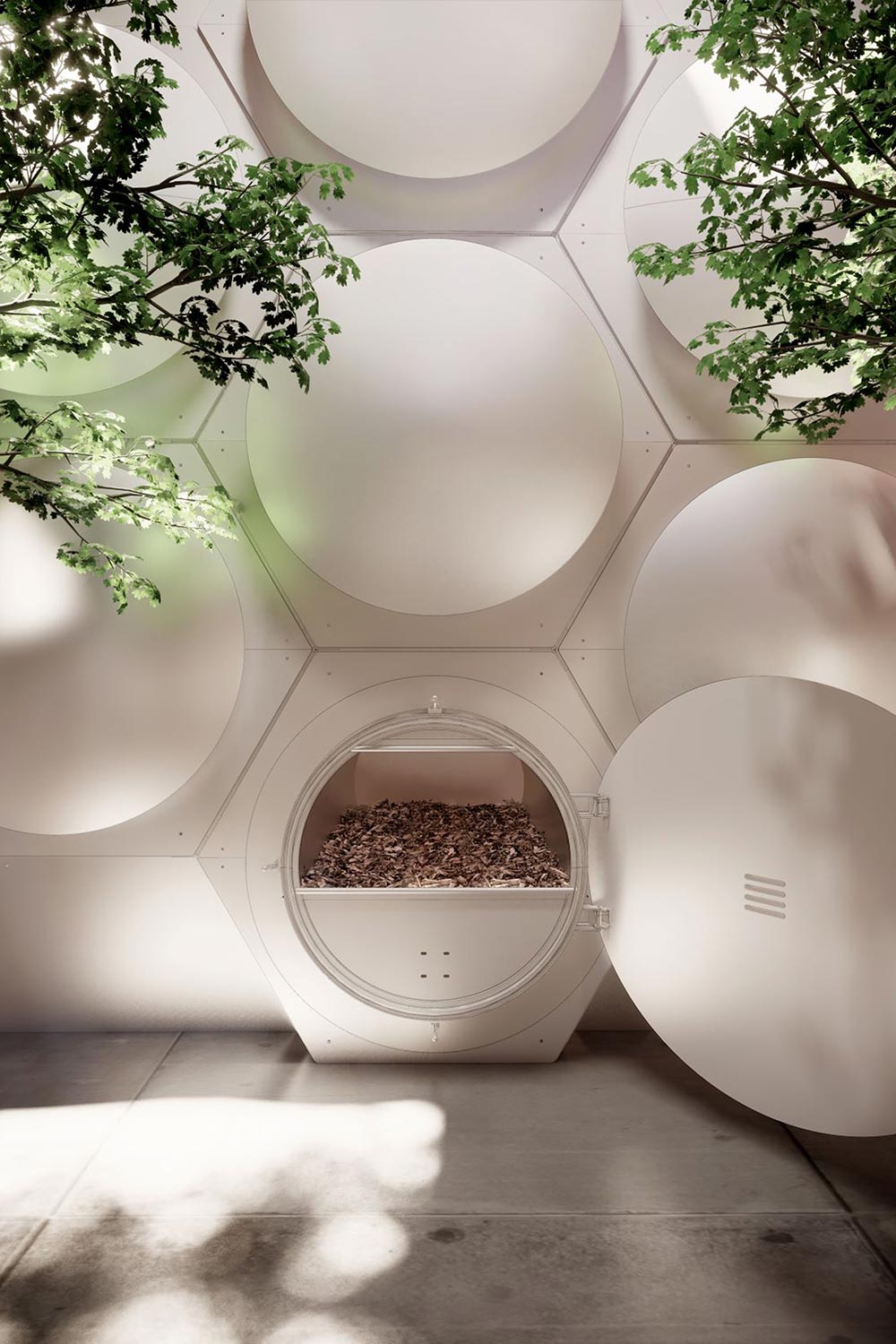死后也要环保,细数绿色殡葬方案

每年,美国排放的二氧化碳中有超过30万吨来自于一个令人意想不到的群体:“尸体”。有超过半数的美国人选择在死后火化,结果,其碳排放相当于每年42,532户家庭能源消费碳排放。火化呈现出上升趋势,未来20年,火化率预计将达到78%。
研究显示,传统的土葬对于地球来说危害更大。每年有超过数百万吨的防腐液进入了地下,棺材制作每年消耗的硬木达到了2000万板英尺。
看来,葬礼过后,留下的不仅仅是悲痛的亲人,还有对环境的危害。而且人们也注意到了这一点。
一些人决心要降低自己最后的行为对地球的伤害,在他们的领导下,一场“绿色殡葬运动”正缓慢地在全美兴起。研究表明,大多数美国人将环境保护视为其首要责任,而且各大城市也遇到了墓地空间方面的麻烦,因为没有足够的空间来容纳即将在未来数十年入土的7000多万婴儿潮时代人口。尽管大多数天主教、犹太教和穆斯林信徒都更愿意土葬,而印度教和佛教则倾向于火葬,但美国教堂集会出席率跌至历史新低,有22%的美国人称自己没有加入任何宗教。
环保的尸体处理方案已变得更多元化,包括无防腐剂埋葬,使用水而不是火来溶解尸体,此外,更多的方案还在酝酿之中。今年晚些时候,华盛顿州“堆肥葬”的法律将生效,科罗拉多州和加州也打算效仿这一举措。
这些不同的尸体处理方式正在动摇210亿美元的殡葬行业,后者因其因循守旧的态度而闻名。
在19世纪末之前,人死后的尸体由其家人处理。艾莫利大学教授盖里·拉德曼称,作为殡葬行业的奠基石,防腐处理于1865年合法化,当时,人们在亚伯拉罕•林肯死后对其尸体进行了防腐处理,并展示了数周的时间。盖里写了两本介绍殡葬行业历史的书籍。在20世纪伊始,殡葬业务蓬勃发展,死人的身后事会交由专业的殡葬承办人处理。
多年来,殡葬行业不断发展,棺材涂上了亮漆,装上了缓震装置,坟墓四周用混凝土加固,但这种增长也为行业带来了不良声誉。
绿色殡葬理事会联合创始人乔·瑟希说:“殡葬承办者成为了死亡商人。我觉得这个行业已经造成了一个我们不愿怎么谈论的问题——将哀伤进一步复杂化。”
保护性埋葬
当瑟希在思考“保护性埋葬”(致力于保护环境的埋葬方式)这一理念时,他认为在出台消费者可信赖的生态标准之前,这一理念很难大众化。他说,我们得采取举措来打击“漂绿”做法,它是一种带有欺骗性的伪环保营销,而且已经泛滥成灾。
瑟希说:“我们真的得利用市场来帮助治疗地球。”
他付诸了行动,并通过与环保领袖和殡葬服务提供商合作,为殡葬馆、制造商和公墓制定了一套标准,该标准摒弃了传统埋葬实践中不利于环境的组件。2005年,他成立了绿色埋葬委员会,设立了一个独立的第三方标准制定者。该委员会提供三个级别的认证——混合、绿色以及保护,所有这一切都禁止使用防腐剂以及混凝土坟墓加固,并要求埋葬用棺材使用可生物降解的材料。

绿色殡葬服务标准还邀请哀思中的亲人参与尸体的处理流程,这一举措一直以来被传统殡葬服务抛之脑后。
《绿色死亡》一书作者苏珊·凯利称:“谈死色变的现象依然存在,很多人对此感到厌烦。绿色殡葬运动在很多方面不仅仅只是涉及环保问题,而且让人们重新熟知自身的身后事。”
绿色埋葬理事会主任韦伯斯特·李说,如今,美国共有260个绿色埋葬公墓,其中超过半数于过去7年之间开设。她说,新罕布什尔州绿色埋葬点的成本仅有400美元,而纽约的埋葬点则高达1.8万美元。Everplan.com称,传统埋葬地点的平均成本在1500-2500美元之间。
水解
另一种吸引了不少注意力的殡葬服务为加碱水解,又称水解。这个流程与传统的火化类似,只不过不是用火来破坏碳基有机质,而是通过水、碱以及加热来溶解尸体。这两种方法都会留下骨骼,后者会被压成粉末状,也就是骨灰。然而水解无需燃烧,因此没有空气污染。生产水解设备的美国公司Bio-Response Solutions称这一流程节省了90%火化所需的能源,其碳印记只有火化的10%。
在明尼苏达州,梅约诊所通过推动2003年水解合法化,为水解的商业化铺平了道路,这样,该技术便可以用于其获捐尸体的最后处理。数年后,杰森·布拉德肖寻求在其公司Bradshaw Funeral & Cremation Services中增加焚化业务,该公司在双子城地区经营数家殡葬馆。当时,布拉德肖说,近70%的明尼苏达州居民都会选择火化。
然而,该公司其他两家殡仪馆有关增加焚化服务的许可申请遭到了当地城市议会的投票否决。
布拉德肖称:“这为我们尝试新事物提供了一次机会。”
他举办了多次群体讨论,并最终决定投资加碱水解系统,造价75万美元。其公司自2013年开始向大众提供这一服务。布拉德肖通过此举成为了美国第一家提供水解服务的殡仪馆之一。

布拉德肖说:“这个主意是我们自己想出来的……我们从来没有想过要成为第一个吃螃蟹的人。成为某个领域的先驱是一件很有意思的事情,由其在这个鲜有变化的行业。”
布拉德肖说,第一批希望水解的家庭在此之前就已经表达了希望在其亲人去世后将尸体焚化的意愿。梅约诊所在美国有着良好的声誉,因此,人们不大会觉得其家庭成员成为了某种试验品。
他说:“不可思议的是,水解从一开始便很受欢迎。说真的,我们对此感到有点惊讶。人们说,‘这个听起来更好,不仅对环境有利,而且水也比火更温和一些。’”
布拉德肖说,在有意焚化的人群中,有70%-80%选择水解。他的客户数量最近超过了2000个家庭,他们都选择为亲人实施加碱水解。
有20个州已经将加碱水解合法化,有的通过对焚化的定义进行修改,有的则是在法律文书中增加了一种新的尸体处理方式。北美焚化协会执行总监芭芭拉·柯米思称,在这些州中,不到10个州拥有提供水解服务的设施,在美国和加拿大共有35家服务提供商。水解服务的费用与火化类似,全美平均价格2195美元,不过有一些经营者认为它是一种高端服务。
水解服务提供商数量偏少的原因可能在于,这项流程相对来讲知道的人并不多。美国殡葬承办人协会2019年的调查显示,仅有7.5%的受调对象听说过加碱水解服务。
另一个原因在于,葬礼承办人可能并未看到其中的财务收益。柯米思指出,水解技术仍是一种新兴技术。他说,尽管布拉德肖的水解系统耗费约4个小时的时间,但低压系统可能会需要高达10个小时的时间。柯米思说,传统的火化仅需要2-3个小时的时间。
柯米思说:“这项服务的量还不是很大,而且依然处于初期。”
堆肥葬
行业最新出现的尸体处理方法属于自然生物降解,说白了就是将人类尸体变为肥料。这个理念是卡特琳娜·斯佩德的作品,她在2013年学习建筑学时曾研究过如何让自然介入人的葬礼,当时,一位朋友向她介绍了牲畜堆肥理念。
斯佩德说:“我觉得这个主意很好,人类尸体也可以这么做。”
因此,她于2017年成立了Recompose公司,并开发了一个加速堆肥流程的方式,将尸体放在容器中,然后用诸如木屑和苜蓿草等生物材料进行包裹。在通风过程中增添氧气,此举能为微生物活动提供绝佳的环境。在约一个月的时间内,尸体将被降解为一立方英码的尘土。

斯佩德说:“当这个过程发生时,我感觉有点像变魔术一样。每一次都会让我感到惊讶。”
在打造这个系统时,斯佩德与华盛顿州立大学的科学家合作,帮助确定尸体分解后的残留物质是否安全。答案是肯定的,它减少了95%的用药,而且分解后的产物符合州以及联邦有关土壤对人类和植物生命的安全要求。
Recompose的研究显示,自然生物降解使用的能耗是焚化的八分之一,能够减少一公吨的碳排放。如果2018年仅有10%的美国民众选择使用生物降解尸体,那么减碳效果将相当于让61339辆乘用车停开一年的时间。
斯佩德与华盛顿州的立法人员合作,为自然生物降解成为合法的尸体处理方案铺路。立法人员已经讨论过水解方式,因此已经为接纳更多的尸体解决方案打好了基础。
新法律实现了加碱水解的合法化,将于5月生效,但Recompose的设施要到2021年初才能运行。在9个月的时间内,公司从投资者那里筹集了470万美元,向潜在客户发送的资讯如今已有1.7万名受众。
Recompose只提供一种服务:自然生物降解,5500美元,其中包括一个追悼仪式。全美殡仪和传统土葬平均成本为7640美元。
西雅图似乎是开展其业务的最佳场所。其2018年的焚化人数超过了4.2万,华盛顿州的人均焚化率在美国各州中排名第二,也是美国宗教信奉率最低的州之一。
就这种新的殡葬方式而言,唯一向华盛顿州立法人员提出反对意见的群体是天主教堂。
美国22%的民众都信奉天主教,后者于1963年才正式允许火化,然而,教堂在2016年发布了具体指导意见,称骨灰不应泼洒或留在罐中,而是应该保存在像公墓这样的神圣之地。
华盛顿州天主教会议执行总监马里奥·维兰努瓦称:“葬礼更多的在于尊重死者,尊重肉体和遗留之物,它与我们有关复活的信仰息息相关。”天主教宗教认为,当耶稣第二次降临人世时,死去的基督教徒将复活,包括肉体、灵魂和精神。
天主教的另一个分支新教徒是美国最大的宗教团体,它对于复活以及什么值得尊重有着更宽泛的理解。惠顿学院比利格拉汉姆中心执行总监艾德·施特茨称,他认为大多数福音派新教徒(占美国人口的约25%)会对新的下葬方式持开放态度,因为他们有关死亡的信仰焦点并非集中在物质遗存。
施特茨说:“重要的并非是肉体的死亡,而是上帝复活的力量。福音派新教徒对于任何体面的肉体处理方式都没有意见,因为他们关注的是复活,但这并不需要完美的肉体。按照这种说法,那么那些在事故中惨死的人们在天堂岂不是也得缺胳膊少腿?”
犹太教是美国基督教之外的第一大教。环境与犹太人生命联盟主席拉比·弗雷德·舍兰德·杜布称,犹太人的殡葬已经达到了“90%的绿色埋葬”。杜布称,尽管他们仍然使用混凝土加固墓地,但犹太葬礼禁止使用防腐剂,而且其传统要求使用100%生物降解型寿衣和棺材。
他说:“棺材有个经典的名字‘纯松木盒子’,这个纯松树盒子的妙处在于,它不仅有正当的社会意义,同时在生态方面也是可持续的。从哪来,回哪去,这是理所当然的。”
杜布称,其他下葬方案对于犹太教来说是难以接受的,因为这些方式并不能立即将肉体埋葬于地下。
除了信仰方面的问题之外,人们还对自然生物降解业务的可行性存在一些疑问。
在全美运营殡仪馆咨询业务40多年的大卫·尼克松便质疑是否真的存在这方面的需求。
尼克松说:“对于那些真的有意体验一些不同方案的消费者来说,服务提供商必须进行大力推广。除非这类提供商能够吸引当前殡葬承办人群体的注意力,否则真的将是一场苦战。”
尼克松称,新事物的引入在任何行业来说都是困难的,在殡葬行业尤为如此。他还指出,该行业由组织严密的小型社区构成,不愿改变。那些从事殡葬业务的人士倾向于让客户和家庭在有人去世时选择同一家殡仪馆。
尼克松说:“这类葬礼令人感到不安,而[失去亲人的人们]又会回归他们熟悉的做法。殡葬服务[服务提供商]与消费者不愿做出改变,这让做出真正的改变变得非常具有挑战性。”
Recompose是一家公益公司,其投资者亦是如此,涵盖个人、投资集团和其他基金,它们每家至少投资了10万美元,斯佩德将其称之为“志同道合”的投资者。他们坚信,从长远来看,公司将改变殡葬服务的格局,而且他们也深知业务的增长及其回报可能会十分缓慢。
在让西雅图设施运转的同时,斯佩德还在努力打造一个船舶系统,这样便可以向国外的业务授权。华盛顿州的法律将于今年生效,科罗拉多州的立法人员在1月份提交了一个类似的法案,加州在2月份亦提交了该法案。
加州下院议员克里斯提娜·加西亚说:“我希望成为一棵树。”她甚至连树种都想好了:乌梅果树。
保持好的空气质量以及成为优秀的环境管理者对于加西亚来说都是非常重要的事情,因此支持这一法案将允许她在身后继续这一遗留事业,并让其他人也能从事这一事业。她认为,随着越来越多的加州人了解这一方案,自然生物降解的需求将越来越高。
她说:“我的工作是为人们提供可供选择的方案。很多人都会说,这个方案并不是为自己准备的,而且依然会有很多人采用传统的殡葬服务。不过,此举会让(殡葬)行业重新思考其业务,因为空间还是有的。”(财富中文网)
译者:冯丰
审校:夏林
每年,美国排放的二氧化碳中有超过30万吨来自于一个令人意想不到的群体:“尸体”。有超过半数的美国人选择在死后火化,结果,其碳排放相当于每年42,532户家庭能源消费碳排放。火化呈现出上升趋势,未来20年,火化率预计将达到78%。
研究显示,传统的土葬对于地球来说危害更大。每年有超过数百万吨的防腐液进入了地下,棺材制作每年消耗的硬木达到了2000万板英尺。
看来,葬礼过后,留下的不仅仅是悲痛的亲人,还有对环境的危害。而且人们也注意到了这一点。
一些人决心要降低自己最后的行为对地球的伤害,在他们的领导下,一场“绿色殡葬运动”正缓慢地在全美兴起。研究表明,大多数美国人将环境保护视为其首要责任,而且各大城市也遇到了墓地空间方面的麻烦,因为没有足够的空间来容纳即将在未来数十年入土的7000多万婴儿潮时代人口。尽管大多数天主教、犹太教和穆斯林信徒都更愿意土葬,而印度教和佛教则倾向于火葬,但美国教堂集会出席率跌至历史新低,有22%的美国人称自己没有加入任何宗教。
环保的尸体处理方案已变得更多元化,包括无防腐剂埋葬,使用水而不是火来溶解尸体,此外,更多的方案还在酝酿之中。今年晚些时候,华盛顿州“堆肥葬”的法律将生效,科罗拉多州和加州也打算效仿这一举措。
这些不同的尸体处理方式正在动摇210亿美元的殡葬行业,后者因其因循守旧的态度而闻名。
在19世纪末之前,人死后的尸体由其家人处理。艾莫利大学教授盖里·拉德曼称,作为殡葬行业的奠基石,防腐处理于1865年合法化,当时,人们在亚伯拉罕•林肯死后对其尸体进行了防腐处理,并展示了数周的时间。盖里写了两本介绍殡葬行业历史的书籍。在20世纪伊始,殡葬业务蓬勃发展,死人的身后事会交由专业的殡葬承办人处理。
多年来,殡葬行业不断发展,棺材涂上了亮漆,装上了缓震装置,坟墓四周用混凝土加固,但这种增长也为行业带来了不良声誉。
绿色殡葬理事会联合创始人乔·瑟希说:“殡葬承办者成为了死亡商人。我觉得这个行业已经造成了一个我们不愿怎么谈论的问题——将哀伤进一步复杂化。”
保护性埋葬
当瑟希在思考“保护性埋葬”(致力于保护环境的埋葬方式)这一理念时,他认为在出台消费者可信赖的生态标准之前,这一理念很难大众化。他说,我们得采取举措来打击“漂绿”做法,它是一种带有欺骗性的伪环保营销,而且已经泛滥成灾。
瑟希说:“我们真的得利用市场来帮助治疗地球。”
他付诸了行动,并通过与环保领袖和殡葬服务提供商合作,为殡葬馆、制造商和公墓制定了一套标准,该标准摒弃了传统埋葬实践中不利于环境的组件。2005年,他成立了绿色埋葬委员会,设立了一个独立的第三方标准制定者。该委员会提供三个级别的认证——混合、绿色以及保护,所有这一切都禁止使用防腐剂以及混凝土坟墓加固,并要求埋葬用棺材使用可生物降解的材料。
绿色殡葬服务标准还邀请哀思中的亲人参与尸体的处理流程,这一举措一直以来被传统殡葬服务抛之脑后。
《绿色死亡》一书作者苏珊·凯利称:“谈死色变的现象依然存在,很多人对此感到厌烦。绿色殡葬运动在很多方面不仅仅只是涉及环保问题,而且让人们重新熟知自身的身后事。”
绿色埋葬理事会主任韦伯斯特·李说,如今,美国共有260个绿色埋葬公墓,其中超过半数于过去7年之间开设。她说,新罕布什尔州绿色埋葬点的成本仅有400美元,而纽约的埋葬点则高达1.8万美元。Everplan.com称,传统埋葬地点的平均成本在1500-2500美元之间。
水解
另一种吸引了不少注意力的殡葬服务为加碱水解,又称水解。这个流程与传统的火化类似,只不过不是用火来破坏碳基有机质,而是通过水、碱以及加热来溶解尸体。这两种方法都会留下骨骼,后者会被压成粉末状,也就是骨灰。然而水解无需燃烧,因此没有空气污染。生产水解设备的美国公司Bio-Response Solutions称这一流程节省了90%火化所需的能源,其碳印记只有火化的10%。
在明尼苏达州,梅约诊所通过推动2003年水解合法化,为水解的商业化铺平了道路,这样,该技术便可以用于其获捐尸体的最后处理。数年后,杰森·布拉德肖寻求在其公司Bradshaw Funeral & Cremation Services中增加焚化业务,该公司在双子城地区经营数家殡葬馆。当时,布拉德肖说,近70%的明尼苏达州居民都会选择火化。
然而,该公司其他两家殡仪馆有关增加焚化服务的许可申请遭到了当地城市议会的投票否决。
布拉德肖称:“这为我们尝试新事物提供了一次机会。”
他举办了多次群体讨论,并最终决定投资加碱水解系统,造价75万美元。其公司自2013年开始向大众提供这一服务。布拉德肖通过此举成为了美国第一家提供水解服务的殡仪馆之一。
布拉德肖说:“这个主意是我们自己想出来的……我们从来没有想过要成为第一个吃螃蟹的人。成为某个领域的先驱是一件很有意思的事情,由其在这个鲜有变化的行业。”
布拉德肖说,第一批希望水解的家庭在此之前就已经表达了希望在其亲人去世后将尸体焚化的意愿。梅约诊所在美国有着良好的声誉,因此,人们不大会觉得其家庭成员成为了某种试验品。
他说:“不可思议的是,水解从一开始便很受欢迎。说真的,我们对此感到有点惊讶。人们说,‘这个听起来更好,不仅对环境有利,而且水也比火更温和一些。’”
布拉德肖说,在有意焚化的人群中,有70%-80%选择水解。他的客户数量最近超过了2000个家庭,他们都选择为亲人实施加碱水解。
有20个州已经将加碱水解合法化,有的通过对焚化的定义进行修改,有的则是在法律文书中增加了一种新的尸体处理方式。北美焚化协会执行总监芭芭拉·柯米思称,在这些州中,不到10个州拥有提供水解服务的设施,在美国和加拿大共有35家服务提供商。水解服务的费用与火化类似,全美平均价格2195美元,不过有一些经营者认为它是一种高端服务。
水解服务提供商数量偏少的原因可能在于,这项流程相对来讲知道的人并不多。美国殡葬承办人协会2019年的调查显示,仅有7.5%的受调对象听说过加碱水解服务。
另一个原因在于,葬礼承办人可能并未看到其中的财务收益。柯米思指出,水解技术仍是一种新兴技术。他说,尽管布拉德肖的水解系统耗费约4个小时的时间,但低压系统可能会需要高达10个小时的时间。柯米思说,传统的火化仅需要2-3个小时的时间。
柯米思说:“这项服务的量还不是很大,而且依然处于初期。”
堆肥葬
行业最新出现的尸体处理方法属于自然生物降解,说白了就是将人类尸体变为肥料。这个理念是卡特琳娜·斯佩德的作品,她在2013年学习建筑学时曾研究过如何让自然介入人的葬礼,当时,一位朋友向她介绍了牲畜堆肥理念。
斯佩德说:“我觉得这个主意很好,人类尸体也可以这么做。”
因此,她于2017年成立了Recompose公司,并开发了一个加速堆肥流程的方式,将尸体放在容器中,然后用诸如木屑和苜蓿草等生物材料进行包裹。在通风过程中增添氧气,此举能为微生物活动提供绝佳的环境。在约一个月的时间内,尸体将被降解为一立方英码的尘土。
斯佩德说:“当这个过程发生时,我感觉有点像变魔术一样。每一次都会让我感到惊讶。”
在打造这个系统时,斯佩德与华盛顿州立大学的科学家合作,帮助确定尸体分解后的残留物质是否安全。答案是肯定的,它减少了95%的用药,而且分解后的产物符合州以及联邦有关土壤对人类和植物生命的安全要求。
Recompose的研究显示,自然生物降解使用的能耗是焚化的八分之一,能够减少一公吨的碳排放。如果2018年仅有10%的美国民众选择使用生物降解尸体,那么减碳效果将相当于让61339辆乘用车停开一年的时间。
斯佩德与华盛顿州的立法人员合作,为自然生物降解成为合法的尸体处理方案铺路。立法人员已经讨论过水解方式,因此已经为接纳更多的尸体解决方案打好了基础。
新法律实现了加碱水解的合法化,将于5月生效,但Recompose的设施要到2021年初才能运行。在9个月的时间内,公司从投资者那里筹集了470万美元,向潜在客户发送的资讯如今已有1.7万名受众。
Recompose只提供一种服务:自然生物降解,5500美元,其中包括一个追悼仪式。全美殡仪和传统土葬平均成本为7640美元。
西雅图似乎是开展其业务的最佳场所。其2018年的焚化人数超过了4.2万,华盛顿州的人均焚化率在美国各州中排名第二,也是美国宗教信奉率最低的州之一。
就这种新的殡葬方式而言,唯一向华盛顿州立法人员提出反对意见的群体是天主教堂。
美国22%的民众都信奉天主教,后者于1963年才正式允许火化,然而,教堂在2016年发布了具体指导意见,称骨灰不应泼洒或留在罐中,而是应该保存在像公墓这样的神圣之地。
华盛顿州天主教会议执行总监马里奥·维兰努瓦称:“葬礼更多的在于尊重死者,尊重肉体和遗留之物,它与我们有关复活的信仰息息相关。”天主教宗教认为,当耶稣第二次降临人世时,死去的基督教徒将复活,包括肉体、灵魂和精神。
天主教的另一个分支新教徒是美国最大的宗教团体,它对于复活以及什么值得尊重有着更宽泛的理解。惠顿学院比利格拉汉姆中心执行总监艾德·施特茨称,他认为大多数福音派新教徒(占美国人口的约25%)会对新的下葬方式持开放态度,因为他们有关死亡的信仰焦点并非集中在物质遗存。
施特茨说:“重要的并非是肉体的死亡,而是上帝复活的力量。福音派新教徒对于任何体面的肉体处理方式都没有意见,因为他们关注的是复活,但这并不需要完美的肉体。按照这种说法,那么那些在事故中惨死的人们在天堂岂不是也得缺胳膊少腿?”
犹太教是美国基督教之外的第一大教。环境与犹太人生命联盟主席拉比·弗雷德·舍兰德·杜布称,犹太人的殡葬已经达到了“90%的绿色埋葬”。杜布称,尽管他们仍然使用混凝土加固墓地,但犹太葬礼禁止使用防腐剂,而且其传统要求使用100%生物降解型寿衣和棺材。
他说:“棺材有个经典的名字‘纯松木盒子’,这个纯松树盒子的妙处在于,它不仅有正当的社会意义,同时在生态方面也是可持续的。从哪来,回哪去,这是理所当然的。”
杜布称,其他下葬方案对于犹太教来说是难以接受的,因为这些方式并不能立即将肉体埋葬于地下。
除了信仰方面的问题之外,人们还对自然生物降解业务的可行性存在一些疑问。
在全美运营殡仪馆咨询业务40多年的大卫·尼克松便质疑是否真的存在这方面的需求。
尼克松说:“对于那些真的有意体验一些不同方案的消费者来说,服务提供商必须进行大力推广。除非这类提供商能够吸引当前殡葬承办人群体的注意力,否则真的将是一场苦战。”
尼克松称,新事物的引入在任何行业来说都是困难的,在殡葬行业尤为如此。他还指出,该行业由组织严密的小型社区构成,不愿改变。那些从事殡葬业务的人士倾向于让客户和家庭在有人去世时选择同一家殡仪馆。
尼克松说:“这类葬礼令人感到不安,而[失去亲人的人们]又会回归他们熟悉的做法。殡葬服务[服务提供商]与消费者不愿做出改变,这让做出真正的改变变得非常具有挑战性。”
Recompose是一家公益公司,其投资者亦是如此,涵盖个人、投资集团和其他基金,它们每家至少投资了10万美元,斯佩德将其称之为“志同道合”的投资者。他们坚信,从长远来看,公司将改变殡葬服务的格局,而且他们也深知业务的增长及其回报可能会十分缓慢。
在让西雅图设施运转的同时,斯佩德还在努力打造一个船舶系统,这样便可以向国外的业务授权。华盛顿州的法律将于今年生效,科罗拉多州的立法人员在1月份提交了一个类似的法案,加州在2月份亦提交了该法案。
加州下院议员克里斯提娜·加西亚说:“我希望成为一棵树。”她甚至连树种都想好了:乌梅果树。
保持好的空气质量以及成为优秀的环境管理者对于加西亚来说都是非常重要的事情,因此支持这一法案将允许她在身后继续这一遗留事业,并让其他人也能从事这一事业。她认为,随着越来越多的加州人了解这一方案,自然生物降解的需求将越来越高。
她说:“我的工作是为人们提供可供选择的方案。很多人都会说,这个方案并不是为自己准备的,而且依然会有很多人采用传统的殡葬服务。不过,此举会让(殡葬)行业重新思考其业务,因为空间还是有的。”(财富中文网)
译者:冯丰
审校:夏林
Each year in the United States, more than 300,000 metric tons of carbon dioxide are emitted by a surprising group of people: the dead. With more than half of Americans choosing to be cremated upon their death, the result is the carbon emissions equivalent to the energy used by 42,532 homes in a year. It is an upward trend, with the cremation rate projected to reach 78% in the next 20 years.
Traditional burials, studies show, are even worse for the planet. More than 4 million gallons of embalming fluids are released into the ground each year, and 20 million board feet of hardwood is used annually for caskets.
These long-accepted body disposal processes are leaving behind more than just grieving relatives, and people are taking note.
Led by those determined to make their last act on the planet a less toxic one, a green death movement is slowly gaining momentum across the country. Studies show that most Americans view the protection of the environment as a top priority, and cities are struggling to make space in graveyards to accommodate the more than 70 million baby boomers expected to die in the coming decades. While most Christian, Jewish, and Muslim faiths favor burial, and Hindus and Buddhists favor cremation, church attendance in the United States has reached an all-time low, with 22% of Americans identifying as unaffiliated with any religion.
Eco-friendly options have grown to include burial without the toxins and cremation that uses water instead of fire—and there are more options on the horizon. Later this year, a Washington law legalizing the composting of human bodies will take effect, a move that Colorado and California are seeking to replicate.
These alternatives for body disposal are shaking up the $21 billion funeral industry, one that isn’t particularly known for embracing change.
Until the end of the 19th century, when someone died the body was cared for by family members. Embalming, the cornerstone of the funeral industry, was legitimized in 1865 when Abraham Lincoln’s body was embalmed and displayed for weeks after his death, according to Gary Laderman, Emory University professor and author of two books on the history of the funeral industry. By the beginning of the 20th century, the business was flourishing, with professional undertakers handling arrangements for the deceased.
Over the years, the funeral industry grew to include cushions installed in varnished caskets and grave sites lined with concrete, and with that growth came a bad reputation. The sheer idea of having to make a financial transaction and worry about being upsold during what may amount to the most upending moment of your life is reason enough for some to take issue.
“Funeral directors were made into death merchants,” said Joe Sehee, cofounder of the Green Burial Council. “I think the industry has contributed to a problem that we don’t talk a lot about, which is complicated grief.”
Conservation burial
When Sehee was contemplating the idea for conservation burial, a burial that works to conserve the environment, he didn’t think the idea would catch on unless there were ecological standards that consumers could trust. Something, he said, needed to combat the “greenwashing,” or deceptive eco-friendly marketing, that had become pervasive.
“We really need to leverage the marketplace to help heal the planet,” Sehee said.
He got to work, collaborating with environmental leaders and death care providers to create a set of standards for funeral homes, manufacturers, and cemeteries that strip away the environmentally cringeworthy components of traditional burial practices. In 2005 he founded the Green Burial Council, creating an independent third-party standard-bearer. The council offers three certification classifications—hybrid, green, and conservation—all of which prohibit embalming and concrete grave liners as well as require burial containers be made from biodegradable material.
The green burial standards also invite mourning loved ones to participate in the body disposal process, something that has gone by the wayside in traditional burial over the years.
“There’s a distancing from death that a lot of people are tired of,” said Suzanne Kelly, author of Greening Death. “The green burial movement in many ways isn’t just about the environment; it’s about bringing people back into the fold of our death practices.”
Today there are 260 green burial cemeteries across the country, more than half of which opened in the past seven years, said Lee Webster, director of the Green Burial Council. Green burial plots in New Hampshire cost as little as $400, while plots in New York can reach prices of $18,000, she said. According to Everplan.com, the average cost of a traditional burial plot is between $1,500 and $2,500.
Water cremation
Another death care alternative that has gained some traction is alkaline hydrolysis, or water cremation. The process works similarly to traditional cremation, though instead of destroying organic carbon-based material with fire, it dissolves it in a mixture of water, alkaline chemicals, and heat. Both processes leave behind bone, which is then pulverized into a powder commonly referred to as ashes. Water cremation, however, does not involve combustion, so it does not result in air pollutants. Bio-Response Solutions, a U.S. company that makes water cremation equipment, claims the process saves 90% of the energy of flame cremation and leaves one-tenth of the carbon footprint.
In Minnesota, the Mayo Clinic paved the way for commercial water cremation by pushing for its legalization in 2003 so that it could be used for final disposal of its body donations. A few years later, Jason Bradshaw was looking to add a crematory to his business, Bradshaw Funeral & Cremation Services, which runs several funeral homes in the Twin Cities area. At the time, Bradshaw said, close to 70% of Minnesotans were choosing cremation.
Permit requests to add a crematory by two other other funeral home business owners, however, were voted down by his local city council.
“This was an opportunity to try something different,” Bradshaw said.
He ran focus groups and ultimately decided to invest in the alkaline hydrolysis system, which cost him about $750,000, and his company began offering the service to families in 2013. In doing so, Bradshaw’s business became one of the first funeral homes in the United States to offer this service.
“We were coming up with all of this verbiage on our own…We were never intending to be the first one,” Bradshaw said. “It’s been very interesting to be on the front edge of something, especially in an industry that doesn’t change a lot.”
Bradshaw said that the first families to opt for water cremation came in already wanting cremation for their loved ones. Mayo Clinic has a good reputation in the state, Bradshaw said, which made people feel less as if their family members were a science experiment.
“Overwhelmingly right from the beginning, it was well received. Honestly, we were a little surprised by that,” he said. “People said, ‘This just sounds better,’ whether it was from an environmental perspective or that water is just gentler than flame.”
Between 70% to 80% of his customers interested in cremation choose water cremation, Bradshaw said, and his business recently surpassed a count of 2,000 families who have chosen alkaline hydrolysis for their loved one.
Twenty states have legalized alkaline hydrolysis, whether by altering the definition of cremation or by adding a new form of death disposition to the law books. Of those states, fewer than 10 have facilities that offer the service, amounting to about 35 providers in the U.S. and Canada, Cremation Association of North America executive director Barbara Kemmis said. The price for the service is similar to that of cremation, which has a national average of $2,195, though some practitioners consider it a premium service, Kemmis said.
The low number of providers offering water cremation could be due to the fact that the process is relatively unknown. A 2019 survey conducted by the National Funeral Directors Association showed that only 7.5% of respondents were even aware of alkaline hydrolysis.
Another reason is that funeral directors might not see the financial benefit. The technology for water cremation, Kemmis points out, is still emerging. While Bradshaw’s water cremation system takes about four hours, lower-pressure systems can take up to 10 hours, he said. Traditional cremation, Kemmis said, takes only two to three hours.
“You’re not trading on volume,” Kemmis said. “It’s still early days for sure.”
Composting
The newest death care option introduced into the industry is natural organic reduction, a process that translates to composting a human corpse. The idea was the brainchild of Katrina Spade, who in 2013 was studying architecture and researching how to bring nature into death practices when a friend told her about livestock composting.
“I thought, well, that’s beautiful, we should do that with humans,” Spade said.
So she founded Recompose in 2017 and developed a way to speed up the composting process by cocooning a corpse with organic materials such as wood chips and alfalfa inside a vessel. Oxygen is added through aeration, which provides the perfect recipe for microbial activity. In about a month, the remains are reduced into a cubic yard of soil.
“When that happens, I can’t help but think it’s a bit of magic,” Spade said. “It continues to astound me every time.”
While creating the system, Spade teamed up with scientists at Washington State University to help determine whether composting human remains was safe. The answer was yes—it reduced pharmaceuticals by 95%, and the soil met state and federal safety requirements for human and plant life.
According to a Recompose study, natural organic reduction uses one-eighth of the energy used by cremation and saves one metric ton of carbon from entering the atmosphere. If just 10% of Americans who died in 2018 had opted for this body disposal option, the effect would be equivalent to removing 61,339 passenger vehicles from driving for a year.
Spade worked with lawmakers in the state of Washington to pave the way to allow natural organic reduction to be a legal body disposition option. Legislators had already discussed water cremation, so the groundwork for more death care options had already been laid.
The new law, which also legalizes alkaline hydrolysis, goes into effect in May, but Recompose’s facility won’t be up and running until early 2021. The company raised $4.7 million from investors over a nine-month period, and a newsletter sent out to potential customers now reaches 17,000 people.
Recompose will offer one option: $5,500 for natural organic reduction service, which includes a memorial. The national average cost for a funeral and traditional burial is $7,640.
Seattle ended up being the perfect spot for her business. With more than 42,000 cremations in 2018, Washington ranked the second-highest state for cremations per capita and also ranks among the least religious states in the country.
The only group to voice opposition to Washington lawmakers over the new body disposal options was the Catholic Church.
The Catholic Church, to which 22% of the U.S. belong, only began officially allowing for cremation in 1963, though the church enacted further guidelines in 2016 to clarify that ashes should not be scattered or kept in urns, but kept in a sacred place such as a cemetery.
“It’s more about respect for the deceased, respect for the body and remains, which ties to our beliefs of resurrection,” said Mario Villanueva, executive director of the Washington State Catholic Conference. Christian religions believe that when Christ returns at his second coming, Christians who died will be resurrected—body, soul, and spirit.
Protestants, another Christian sect, who represent the largest religious group in the United States, have a more lenient view on resurrection and what is respectful. Ed Stetzer, executive director of the Billy Graham Center at Wheaton College, said that he believes most Evangelical Protestants, who make up about 25% of the country’s population, would be open to the new death care option because the focus of their beliefs around death don’t rely on the physical remains.
“It’s not the demise of your physical body that matters; it’s the power of God in resurrection that matters,” Stetzer said. “Evangelical Protestants are really okay with any form of respectful body disposition because their focus is on resurrection, and that doesn't mean a perfect body. If you think that, then everyone who was killed in a horrific accident is going to be in a horrific situation in heaven.”
Burial practice for Jews, the largest non-Christian religious group in America, is already “90% green burial,” said Rabbi Fred Scherlinder Dobb, the chair for the Coalition on the Environment and Jewish Life. Though they still use concrete liners, Jewish burials forbid embalming, and tradition mandates a 100% biodegradable shroud and coffin, Dobb said.
“The coffin is classically called the plain pine box, and the beautiful thing about the plain pine box is it is simultaneously socially just and ecologically sustainable,” he said. “We are supposed to return to the earth from which we came.”
Other body disposition options, Dobb said, aren’t as acceptable in the Jewish faith because they don’t involve immediate placement of the body in the ground.
Beyond faith-based concerns, there is also some skepticism about the viability of a natural organic reduction business.
David Nixon, who for more than 40 years has run a funeral home consulting business with clients across the country, has questions about whether the demand is really there.
“It has to be heavily promoted for consumers to really take notice to do something different,” Nixon said. “Unless they catch the attention of the existing network of funeral directors, it’s going to be a real uphill battle.”
Introducing something new is difficult in any business, but especially so in the death care industry, Nixon said. The industry, Nixon said, is made up of a small, tight-knit community that is reluctant to change. Those who work in death care tend to lead the customers, Nixon said, and families tend to go back to the same funeral homes when deaths occur.
“Funerals are unsettling, and [the bereaved] return to familiar surroundings,” Nixon said. “Reluctance to change by death care [business owners] and consumers makes real change very challenging.”
Recompose is a public benefit corporation, so its investors, a mix of individuals, investor groups, and other funds, make a minimum investment of $100,000 and are what Spade calls “heart-aligned” investors. They believe in the company's long-term mission to change the landscape of death care and understand that the business’s growth, and thus their returns, may be slow.
Along with getting the Seattle facility up and running, Spade is also working to create a vessel system that can be licensed out to businesses across the country. But first the laws have to change in each state to allow for the new body disposal process. Washington’s law goes into effect this year, and lawmakers in Colorado introduced a similar bill in January. The following month, California followed suit.
“I want to be a tree,” California assemblymember Cristina Garcia said. She even knows which type: a dark plum fruit tree.
Maintaining good air quality and being a good steward of the environment are key issues for Garcia, so sponsoring the bill will allow her to continue that legacy into the afterlife and for others to do so as well. She believes that demand for natural organic reduction will increase as more Californians learn about it.
“My job is to give people options,” she said. “There will be plenty of people that say this is not for them. You’re still going to have a lot of people who follow the tradition. This is going to make the (death care) industry rethink their business, but there’s space for that.”













